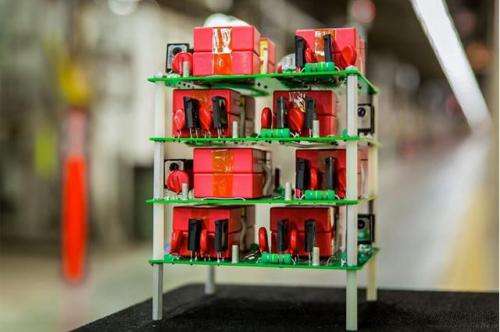SLAC implements pulsed, step-down power converter for energy savings

Depressed collectors have been used for decades to improve the efficiency of vacuum-electronic based RF power sources by recovering energy from the spent electron beam of an RF source, such as a klystron or inductive output tube. The main thrust has been for applications with stringent energy-efficiency requirements, such as space-based communication. To date, there has not been wholesale utilisation of RF sources with depressed collectors for accelerator applications, the likely reasons being that the energy savings over RF sources with conventional, grounded collectors might not justify the additional investment, and that many accelerator-based applications have very short RF pulses with high peak power, making implementation of depressed collectors technically challenging.
However, there has been a gradual change in values, both in the US and around the world. For example, there is a mandate from the US Department of Energy to reduce energy consumption at Federal facilities. Similar efforts exist for many European agencies as well. A corresponding upgrade in technology is necessary in our increasingly energy-conscious societies.
Upgrades
The two main components of a pulsed RF system, the modulator and the RF source, represent a substantial initial investment. At the SLAC National Accelerator Laboratory, we have over 240 of these RF systems which have operated for many decades. We want an upgrade approach that re-uses the existing modulator, while modifying the existing RF source at the regular maintenance interval. An analogy is replacing a burnt-out incandescent bulb with energy-efficient LED lighting. The plug is the same, but a modest investment reduces future energy bills.
Traditional collector biasing technologies require expensive modifications to the modulator. In addition, when driving the RF source cathode with the same supply that you are biasing stages with, problems arise in the very high peak power, short pulse regime.
We developed a self-biasing solution that fundamentally enables high peak power depressed collectors to be more-easily implemented. In addition, the rise and fall times of the modulator pulse can be recovered; these are traditionally wasted. With a transformer-based approach to provide the self-biasing, the size scales with pulse width. Also, the energy built up within the magnetisation inductance cannot be fully recovered, reducing the achievable efficiency. So, an alternate approach was developed, based on a variation of Marx modulator technology.
Inverse Marx modulator
Already, SLAC is involved with more traditional implementations of the Marx topology. For example, we have recently applied solid-state switching to long pulse modulators for use in another accelerator application for the International Linear Collider. Somewhere along the line, we figured out "if this technology works in one direction, can it work in reverse?"
The traditional Marx topology uses low voltage components, arranged in such a way to produce a high voltage. The inverse Marx, in contrast, collects current at high voltage, and recovers it back to a driving modulator at a low voltage. In other words, it is a pulsed, step-down power converter.
It neatly solved the problem with the transformer-based approach, and extended the self-biasing collector technology to longer pulses.
Future energy savings
We recently finished a feasibility design to scale this up to the workhorse S-band, 68MW peak power SLAC klystron, the 5045. The work presented in this Electronics Letters paper shows that the topology is feasible at a relatively low power level. To have significance at a large accelerator facility, we need to ramp up 3 orders of magnitude in power.
If we are successful, the results will be significant. Our studies show that we can recover up to 70% of the energy from the klystron spent electron beam. Implementing this at SLAC will save enough energy per year to power 1,600 average American households.
We are also researching details associated with the collector geometry itself. The metric of success is the overall system efficiency. We could have a perfect inverse Marx, but a low-efficiency collector or modulator system could make the project unsuccessful. Within the next year, we expect to publish results in our high efficiency collector design as well as presenting results on the high-current, passive-switching inverse Marx.
SLAC is in a unique position with design, manufacturing and testing of all components of a RF system at an accelerator facility. It is exciting to see how improvements in one area can have an effect on another. For example, we have ongoing studies on improving the base RF efficiency of the tubes. In conjunction with the collector work, we feel we will be able to reach unprecedented levels of RF efficiency in high power tubes. Greater than 80% efficiency looks possible.
Future developments
The future modulator will deliver as well as recover energy. The concept can be expanded to absorb other wasted energy sources, such as reflected RF power or waste heat. We've termed this approach as Generator for REcovering ENergy from RF (GREEN-RF).
There are many reasons to reduce energy consumption, however, a consistent barrier is economic constraints. Can we save more money with only a modest initial investment? There are difficult engineering challenges to make the answer to that question "yes."
Also, to truly make an impact, we need to commercialise the developed technology. The patent on the technology is presently pending, and we are interested in engaging industrial partners to apply the technology to their existing product lines.
More information: "Inverse Marx modulators for self-biasing klystron depressed collectors." M.A. Kemp Electronics Letters, Volume 50, Issue 18, 28 August 2014, p. 1294 – 1296. DOI: 10.1049/el.2014.1237 , Print ISSN 0013-5194, Online ISSN 1350-911X
Journal information: Electronics Letters
Provided by Institution of Engineering and Technology
This story is published courtesy of Electronics Letters. For additional Electronics Letters news and features visit theiet.org/eletters.



















